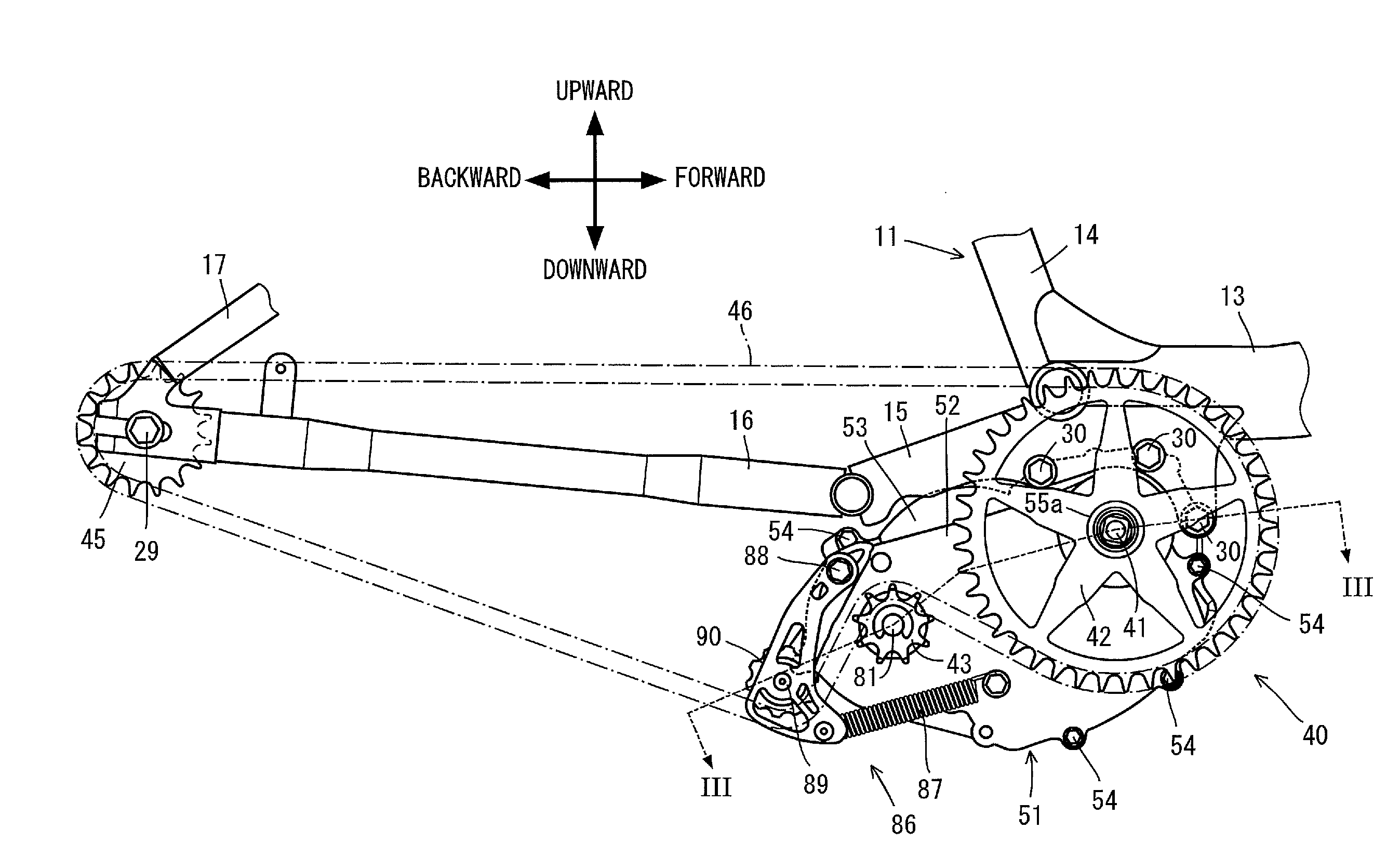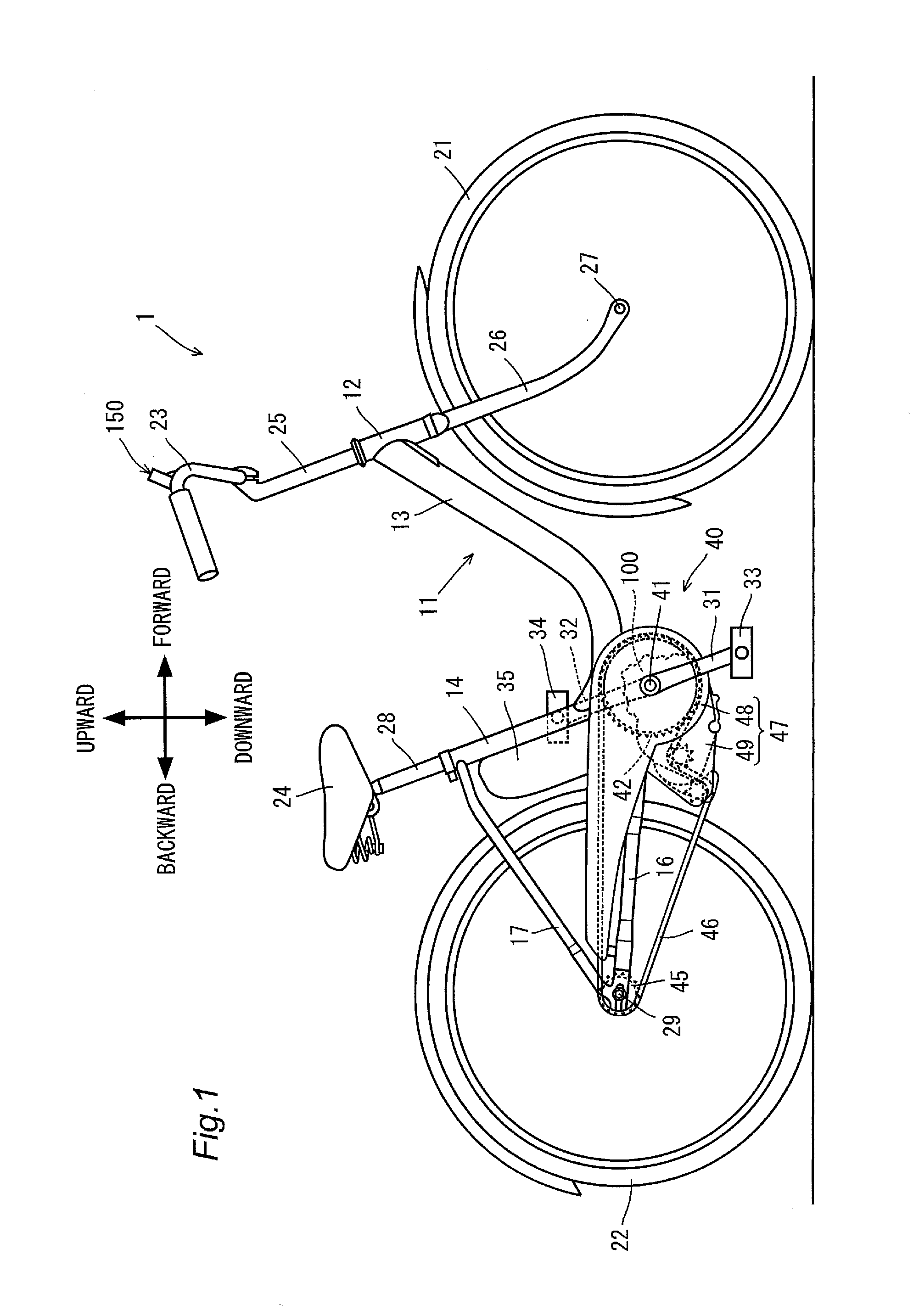Driving unit and battery-assisted bicycle
a technology of driving unit and assist control, which is applied in the direction of bicycle equipment, vehicle components, chain/belt transmission, etc., can solve the problems of reducing pedaling effort and rider feeling uncomfortable, and achieves smooth assist control and increase the assist ratio , not making a rider feel uncomfortabl
- Summary
- Abstract
- Description
- Claims
- Application Information
AI Technical Summary
Benefits of technology
Problems solved by technology
Method used
Image
Examples
first preferred embodiment
[0032]FIG. 1 shows a general structure of a battery-assisted bicycle 1 according to a first preferred embodiment of the present invention. FIG. 2 shows a general structure of a driving unit 40 and a driven sprocket 45 of the battery-assisted bicycle 1. As will be described, in this battery-assisted bicycle 1, a pedaling effort generated by a rider pushing on pedals 33 and 34 (see FIG. 1) is assisted by providing a driving force output by an electric motor 61 (see FIG. 3). More specifically, the battery-assisted bicycle 1 includes a driving mechanism that assists the pedaling effort in addition to a general structure as a bicycle.
[0033]As shown in FIG. 1, the battery-assisted bicycle 1 includes a vehicle body frame 11 that extends in a front-back direction. The battery-assisted bicycle 1 includes a front wheel 21, a rear wheel 22, the handle 23, the seat 24, and the driving unit 40.
[0034]The vehicle body frame 11 includes a head pipe 12, a down frame 13, a seat frame 14, a bracket 15...
second preferred embodiment
[0095]FIG. 7 is a flowchart for illustrating assist stop determination in a battery-assisted bicycle according to a second preferred embodiment of the present invention. The assist stop determination flow according to the second preferred embodiment is preferably different from the assist stop determination flow according to the first preferred embodiment in that a rotation speed of the crankshaft 41 obtained from a determination result from the crank rotation detector 58 is compared to a rotation speed based on an estimated rotation speed that takes errors into account. In the following description, the elements the same as those according to the first preferred embodiment are designated by the same reference characters and their description will not be repeated while only elements different from the first preferred embodiment will be described.
[0096]Steps SB1, SB3, and SB4 in the flow in FIG. 7 are preferably the same as steps SA1, SA3, and SA4 in the flow shown in FIG. 6 accordin...
third preferred embodiment
[0104]FIG. 8 shows a general structure of an assist control stopping unit 120 in a battery-assisted bicycle according to a third preferred embodiment of the present invention. The structure according to the third preferred embodiment is preferably different from the structure according to the first preferred embodiment in that the assist control stopping unit 120 includes a timer 121 that counts a duration in which a detected crank rotation speed is determined to be less than an estimated crank rotation speed, and a detection duration determination unit 122 that determines whether the duration counted by the timer 121 is more than a prescribed time period. In the following description, the same elements as those according to the first preferred embodiment are designated by the same reference characters and their description will not be provided while only elements different from the first preferred embodiment will be described.
[0105]As shown in FIG. 8, the assist control stopping un...
PUM
 Login to View More
Login to View More Abstract
Description
Claims
Application Information
 Login to View More
Login to View More - R&D
- Intellectual Property
- Life Sciences
- Materials
- Tech Scout
- Unparalleled Data Quality
- Higher Quality Content
- 60% Fewer Hallucinations
Browse by: Latest US Patents, China's latest patents, Technical Efficacy Thesaurus, Application Domain, Technology Topic, Popular Technical Reports.
© 2025 PatSnap. All rights reserved.Legal|Privacy policy|Modern Slavery Act Transparency Statement|Sitemap|About US| Contact US: help@patsnap.com



